Jon Stewart on COP15:
| The Daily Show With Jon Stewart | Mon – Thurs 11p / 10c | |||
| World of Warmcraft | ||||
|
||||
Jon Stewart on COP15:
| The Daily Show With Jon Stewart | Mon – Thurs 11p / 10c | |||
| World of Warmcraft | ||||
|
||||
Another widget tracking the state of the deal, this time from WWF:
Like the AOSIS draft, the LTCA draft is a bit coy about developing country actions, and there are a number of unsettled language variations, indicated by brackets. It sets a global goal of 1.5C to 2C, and emissions cuts of 50 to 95 percent from 1990 levels by 2050. Developed countries commit to between 75 and more than 95 percent by 2050, with interim targets of 25 to 45 percent below 1990 by 2020. The developing countries are not explicitly subject to targets, but the combination of supported and autonomous NAMAs is “aimed at achieving a substantial deviation in emissions [in the order of 15-30 percent by 2020] relative to those emissions that would occur in the absence of enhanced mitigation.” The BAU trajectory against which that might be judged is unspecified.
The bracketed options in the text create many possible permutations of the agreement. One is particularly illuminating: the least stringent global target (peak in 2020, 50% below 1990 in 2050) combined with the most stringent developed target (peak in 2011, 45% below 1990 in 2020, 95% below 1990 in 2050). That yields maximum possible emissions in the developing world, given the global and developed budgets.
In that scenario, developing emissions could look like the following:
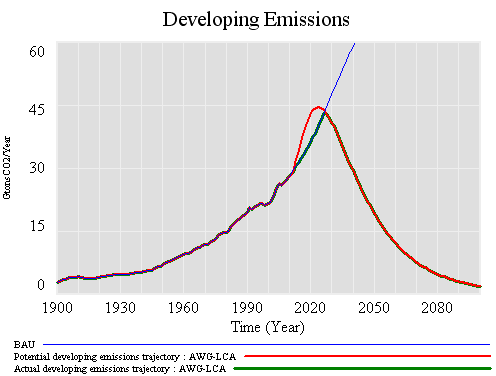
Emissions in the developing countries still must peak before 2030. Note that, as in my AOSIS experiment, the potential emissions budget for developing countries exceeds business-as-usual; if BAU emissions don’t actually rise faster than anticipated, those emissions might be reallocated to delay the peak in emissions a bit, but not more than a few years.
Interestingly, this scenario results in hyper-convergence, with developed emissions per capita falling well below developing emissions per capita.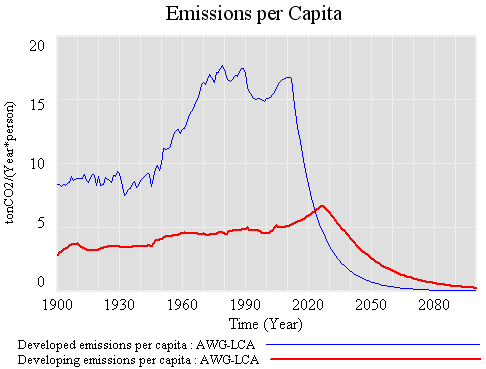
It’s unlikely that this is a physically or politically realizable situation, given that developed countries would have to reduce emissions far faster than the natural rate of capital turnover. The rapid decline would not benefit developing countries either, because buildings and infrastructure cannot be moved elsewhere. If developed countries make less aggressive cuts, to about -30% in 2020 and -85% in 2050, per capita emissions converge between 2030 and 2040. However, in that case, developing country emissions have to peak earlier and fall faster.
The only way to delay the peak in developing country emissions significantly is to delay the global peak. However, meeting the same global 2050 target with a later start requires faster declines in emissions, which quickly become impractical unless you assume some kind of technical miracle (not a robust strategy). Therefore, the only way for developing countries to avoid a peak in emissions in the next decade or two is to abandon any pretense of preserving a reasonable probability of meeting 2C or similar targets. That seems to be what some of the big emerging emitters are implicitly arguing for, but is it what they really want, or in their best interest?
Afterthought: The big challenge is that the global and developed country targets are explicit, while the developing country trajectory those necessitate is not. The draft recognizes means for reducing developing country emissions (supported and autonomous NAMAs), but there’s no coordinating mechanism that ensures the outcome adds up to the global goal.
Two more draft agreements have been released, from AOSIS and the AWG-LCA headed by Michael Zammit Cutajar. I’ve summarized the mitigation targets in the four drafts floating around as a Google spreadsheet, here.
The AOSIS draft is, understandably, very aggressive in its global vision. It seeks 350ppm or better, to limit temperature rise to 1.5C vs. preindustrial. To get there, it seeks a global emissions peak by 2015 and an 85% cut from 1990 levels by 2050. Developed countries are to cut 45% below 1990 by 2020. Deforestation is to be halved by 2020 and halted by 2030. The document gets wishy washy when it comes to other developing country actions though: it talks about NAMAs and “significant deviations from baselines by 2020,” but no specific commitments. In my mind, if you’ve specified targets for the world and for developed countries, you’ve implicitly specified the developing countries’ trajectory, so you might as well say what it is and create commitments to ensure that it is achieved. The burden of those commitments (to the extent that it is a burden, and not a hidden opportunity) may not rest on the developing countries, but someone has to be responsible, or it may not happen.
I ran some rough simulations of the AOSIS targets to see what they really imply for developing countries. Here’s the global 2015 peak and 85% cut from 1990 in 2050:
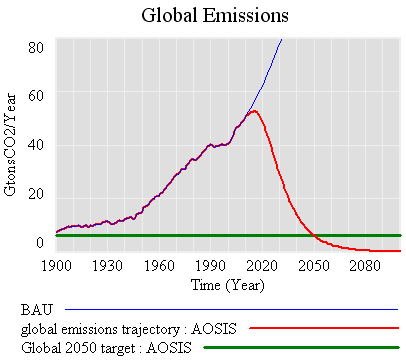
Here’s the developing cut of 45% from 1990 by 2020. The draft doesn’t specify further cuts, but I’ve assumed that the developed countries keep reducing at the same rate (over 7%/yr) afterwards, hitting about -95% from 1990 by 2050:
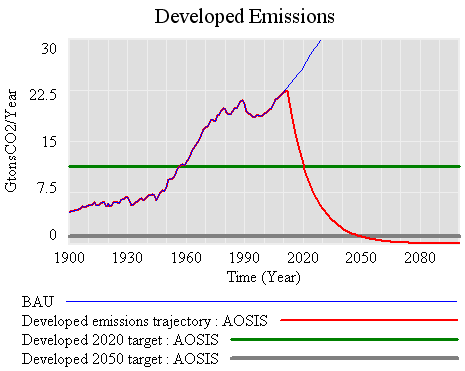
What does that leave for the developing countries?
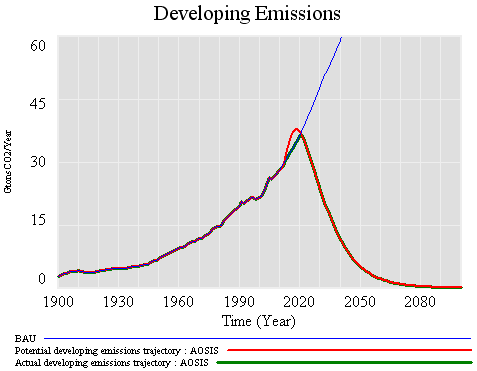
In short, “significant deviations from baselines” has to be the understatement of the century if the AOSIS global target is to be achieved, in spite of the deep cuts in developed country emissions. Developing emissions peak by around 2020 and have fallen by roughly 75% vs 1990 in 2050. This is not a matter of fairness (fairness is about the distribution of costs and benefits). It’s a matter of physics. Global emissions can’t go down rapidly unless both its major components shrink. (Notice also in the graph above that “potential” emissions exceed BAU until 2020; this is because developed country cuts are initially so rapid. Presumably developing country emissions would not actually rise above BAU, which means that the surplus could be used to delay the peak, but only by a year or two.)
Afterthought: as before, this is based on C-ROADS data and projections, with BAU similar to SRES A1FI, though the results are hardly sensitive to the specifics. Thanks to Stephanie & Allison at SI for tracking down the drafts.
The scoreboard widget just hit 1000 installs and 90,000 views. Janice Molloy has a nice perspective on the use of feedback to change the world, on Leverage Points.
Surfing a bit, it looks like the furor over the leaked Danish text actually has at least four major components:
These are evident in coverage in Politico and COP15.dk, for example.
I’ve already tackled #1, which is an illusion based on flawed analysis. I also commented on #2 – whether you set formal targets or not, absolute emissions need to fall in every major region if atmospheric GHG concentrations and radiative imbalance are to stabilize or decline. I don’t have an opinion on #3. #4 is what I’d like to talk about here.
There seem to be two responses to #4: dissatisfaction with the very idea of peaking and declining on anything like that schedule, and dissatisfaction with the burden sharing at the peak.
First, the global trajectory. There are a variety of possible emissions paths that satisfy the criteria in the Danish text. Here’s one (again relying on C-ROADS data and projections, close to A1FI in the future):
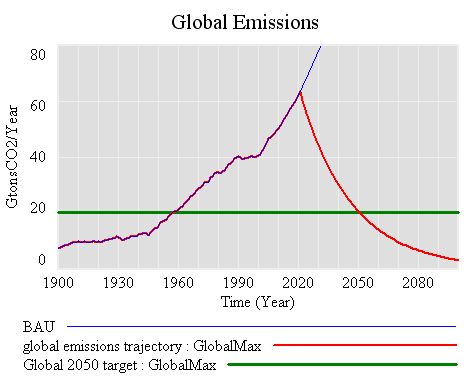
Here, emissions grow along Business-As-Usual (BAU), peak in 2020, then decline at 3.75%/year to hit the 2050 target. This is, of course, a silly trajectory, because its basically impossible to turn the economy on a dime like this, transitioning overnight from growth to decline. More plausible trajectories have to be smooth, like this:
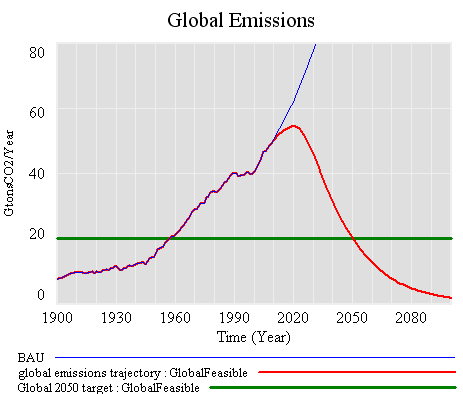
One consequence of the smoothness constraint is that emissions reductions have to be faster later, to make up for the growth that occurs during a gradual transition from growing to declining emissions. Here, they approach -5%/year, vs. -3.5% in the “pointy” trajectory. A similar constraint arises from the need to maintain the area under the emissions curve if you want to achieve similar climate outcomes.
So, anyone who argues for a later peak is in effect arguing for (a) faster reductions later, or (b) weaker ambitions for the climate outcome. I don’t see how either of these is in the best interest of developing countries (or developed, for that matter). (A) means spending at most an extra decade building carbon-intensive capital, only to abandon it at a rapid rate a decade or two later. That’s not development. (B) means more climate damages and other negative externalities, for which growth is unlikely to compensate, and to which the developing countries are probably most vulnerable.
If, for sake of argument, we take my smooth version of the Danish text target as a given, there’s still the question of how emissions between now and 2050 are partitioned. If the developed world shoots for 20% below 1990 by 2020, the trajectory might look like this:
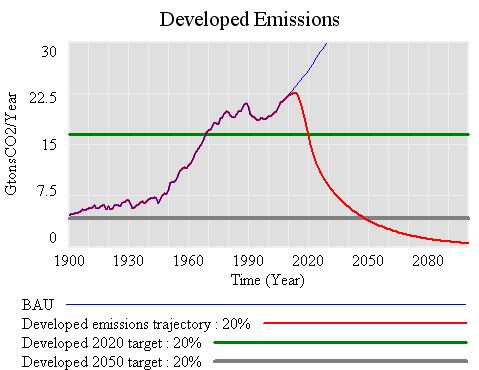
That’s a target that most would consider to be modest, yet to hit it, emissions have to peak by 2012, and decline at up to 8% per year through 2020. It would be easier to achieve in some regions, like the EU, that are already not far from Kyoto levels, but tough for the developed world as a whole. The natural turnover of buildings, infrastructure and power plants is 2 to 4%/year, so emissions declining at 8% per year means some combination of massive retrofits, where possible, and abandonment of carbon-emitting assets. If that were happening in the developed world, in tandem with free trade, rapid growth and no targets in the developing world, it would surely mean massive job dislocations. I expect that would cause the emission control regime in the developed world to crumble.
The -20% in 2020 trajectory creates surprisingly little headroom for growth in the developing world. Emissions can grow only until 2025 (vs. 2020 globally, and 2012 in the developing countries). Thereafter they have to fall at roughly the global rate.
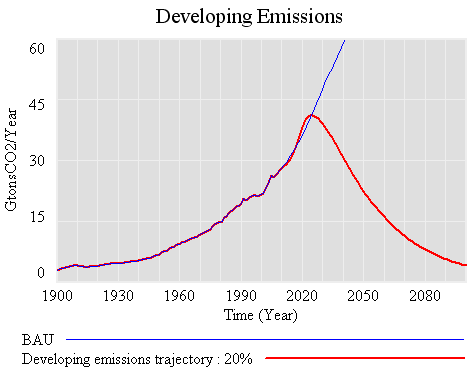
What if the developed world manages to go even faster, achieving -40% from 1990 by 2020, and -90% by 2050? Surprisingly, that buys the developing countries almost nothing. Emissions can rise a little higher, but must peak around the same time, and decline at the same rate. Some of the rise is potentially inaccessible, because it exceeds BAU, and no one really knows how to control economic growth.
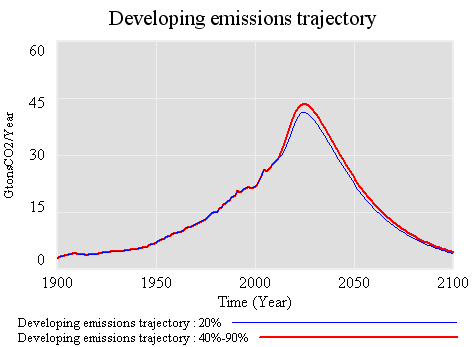
The reason for this behavior is fairly simple: as soon as developed countries make substantial cuts of any size, they become bit players in the global emissions game. Further reductions, acting on a small basis, are very tiny compared to the large basis of developing country emissions. Thus the past is a story of high developed country cumulative emissions, but the future is really about the developing countries’ path. If developing countries want to push the emissions envelope, they have to accept that they are taking a riskier climate future, no matter what the developed world does. In addition, deeper cuts on the part of the developed world become very expensive, because marginal costs grow with the depth of the cut. On the whole everyone would be better off if the developing countries asked for more money rather than deeper emissions cuts in the developed world.
Certainly each of these ideas contains some truth, and each has played a role in the phenomenal growth of the developed world. However, each is also fallacious in important ways. The elements in (1) are certainly correlated, but the relationship between carbon and happiness is mediated by all kinds of institutional and social factors. The key question for (2) is, what kind of infrastructure? Cheap carbon invites building exactly the kind of infrastructure that the developed world is now locked into, and struggling to dismantle. (3) might be true, but I suspect that it has as more to do with inequitable distribution of wealth and power than it does with absolute wealth. Rapid growth can easily increase inequity. The empirical basis of the Kuznets curve in (4) is rather shaky. Attempts to grow out of the negative side effects of growth are essentially a pyramid scheme. Moreover, to the extent that growth is successful, preferences shift to nonmarket amenities like health and clean air, so the cost of the negatives of growth grows.
Rather than following the developed countries down a blind alley, the developing countries could take this opportunity to bypass our unsustainable development path. By implementing emissions controls now, they could start building a low-carbon-friendly infrastructure, and get locked into sustainable technologies, that won’t have to be dismantled or abandoned in a few decades. This would mean developing institutions that internalize environmental externalities and allocate property rights sensibly. As a byproduct, that would help the poorest within their countries avoid the consequences of the new wealth of their elites. Preferences would evolve toward low-carbon lifestyles, rather than shopping, driving, and conspicuous consumption. Now, if we could just figure out how to implement the same insights here in the developed world …
In response to a couple of requests for details, I’ve attached a spreadsheet containing my numbers from the last post on the Danish text: Danish text analysis v3 (updated).
Here it is in words, with a little rounding to simplify:
In 1990, global emissions were about 40 GtCO2eq/year, split equally between developed and developing countries. Due to population disparities, developed emissions per capita were 3.5 times bigger than developing at that point.
The Danish text sets a global target of 50% of 1990 emissions in 2050, which means that the global target is 20 GtCO2eq/year. It also sets a target of 80% (or more) below 1990 for the developed countries, which means their target is 4 GtCO2eq/year. That leaves 16 GtCO2eq/year for the developing world.
According to the “confidential analysis of the text by developing countries” cited in the Guardian, developed countries are emitting 2.7 tonsCO2eq/person/year in 2050, while developing countries emit about half as much: 1.4 tonsCO2eq/person/year. For the developed countries, that’s in line with what I calculate using C-ROADS data and projections. For the developing countries, to get 16 gigatons per year emissions at 1.4 tons per cap, you need 11 billion people emitting. That’s an addition of 6 billion people between 2005 and 2050, implying a growth rate above recent history and way above UN projections.
If you redo the analysis with a more plausible population forecast, per capita emissions convergence is nearly achieved, with developing country emissions per capita within about 25% of developed.
Note log scale to emphasize proportional differences.
The blogosphere is filled with reports, originating in the Guardian, of developing countries’ fury over the leaked “Danish text” – a strawdog draft agreement.
The UN Copenhagen climate talks are in disarray today after developing countries reacted furiously to leaked documents that show world leaders will next week be asked to sign an agreement that hands more power to rich countries and sidelines the UN’s role in all future climate change negotiations.
The angry reaction strikes me as a missed opportunity. But more importantly, I think it’s a product of bad analysis, with an inflated population projection for the developing world creating a false impression of failure to achieve emissions convergence.
Here’s what I think is the essence of the text with respect to emissions trajectories:
3. Recalling the ultimate objective of the Convention, the Parties stress the urgency of action on both mitigation and adaptation and recognize the scientific view that the increase in global average temperature above pre-industrial levels ought not to exceed 2 degrees C. In this regard, the Parties:
- Support the goal of a peak of global emissions as soon as possible, but no later than [2020], acknowledging that developed countries collectively have peaked and that the timeframe for peaking will be longer in developing countries,
- Support the goal of a reduction of global annual emissions in 2050 by at least 50 percent versus 1990 annual emissions, equivalent to at least 58 percent versus 2005 annual emissions. The Parties contributions towards the goal should take into account common but different responsibility and respective capabilities and a long term convergence of per capita emissions.
7. The developed country Parties commit to individual national economy wide targets for 2020. The targets in Attachment A would expect to yield aggregate emissions reductions by X1 percent by 2020 versus 1990 (X2 percent vs. 2005). The purchase of international offset credits will play a supplementary role to domestic action. The developed country Parties support a goal to reduce their emissions of greenhouse gases in aggregate by 80% or more by 2050 versus 1990 (X3 percent versus 2005).
9. The developing country Parties, except the least developed countries which may contribute at their own discretion, commit to nationally appropriate mitigation actions, including actions supported and enabled by technology, financing and capacity-building. The developing countries’ individual mitigation action could in aggregate yield a [Y percent] deviation in [2020] from business as usual and yielding their collective emissions peak before [20XX] and decline thereafter.
These provisions are evidently the source of much of the outrage. Again from the Guardian:
A confidential analysis of the text by developing countries also seen by the Guardian shows deep unease over details of the text. In particular, it is understood to:
• Force developing countries to agree to specific emission cuts and measures that were not part of the original UN agreement;
…
• Not allow poor countries to emit more than 1.44 tonnes of carbon per person by 2050, while allowing rich countries to emit 2.67 tonnes.
I have limited sympathy with the first point. If the world is to avoid the probability of serious climate change, emissions have to fall below natural uptake. That can’t happen if the developed world is shrinking while developing country emissions grow exponentially, so everyone has to play. You can’t cheat mother nature. If we’re serious about mitigation, the conversation has to be about how to help the developing countries peak and reduce, not whether they will.
The last point, concerning per capita emissions disparities, is actually not stated anywhere in the draft. Notice that the article 9 commitment for developing countries are expressed as variables to be filled in. To figure out what’s going on, I ran the numbers myself. I get about the same answer for the developed countries: 2.75 TonCO2eq/person/year. When multiplied by 1.5 billion people, that’s about 4.1 gigatons per year, leaving a budget of about 15.9 for the developing world (half of 1990 emissions of about 20 GtCO2eq, less 4.1). Dividing that by 1.44 yields an expected population in the developing world of 11 billion. That’s a bonkers population forecast, 2 billion above the UN high variant projection. If it came true, it would likely be a disaster in itself. More importantly, the per capita emissions ratios would be expressing a strange notion of (in)equity: the nearly 6 billion people added from 2005-2050 in the developing world would be emitting more than twice as much as all the people in the developing world.
If you rerun the numbers with a more sensible population forecast, with about 7.4 billion people in the developing world, the numbers are 2.75 and 2.15 tonsCO2eq/person/year in the developed and developing countries, respectively. (UN mid variant population projection is 7.9 billion, but I’m sticking with C-ROADS data for convenience, which has slightly different regional definitions). In other words, convergence is at hand: the world has gone from 3.5:1 emissions per cap in 1990 to 1.28:1 – a rather stunning achievement, not something to get mad about. In addition, it’s not physically possible to do much better than that for the developing world, because the developed world represents a small slice of the global population in 2050. For example, even if the developed world could reach zero emissions in 2050, the remaining emissions budget would only permit emissions of 2.7 tonsCO2eq/person/year in the developing countries.
Even if the high population projection came true, I still think it would be a mistake for developing countries to get mad, because there’s article 20:
20. The Parties share the view that the strengthened financial architecture should be able to handle gradually scaled up international public support. International public finance support to developing countries [should/shall] reach the order of [X] billion USD in 2020 on the basis of appropriate increases in mitigation and adaptation efforts by developing countries.
Rather than asking for higher emissions, developing countries could ask for a bigger [X] to compensate for smaller per capita emissions. Then they’d have help moving towards a low-carbon economy, with all the cobenefits that entails. They wouldn’t have to follow the developed world down a fossil-fired, energy intensive path that’s ultimately a dead end. Maybe the real anger arises from the difficulty of getting meaningful financial terms, but that’s the conversation we should be having if we want a shot at 2C or below.
Check my math. If you think I’m right, spread the word. It would be a shame if the possibility of a climate agreement were derailed by a flawed analysis of a draft document. If you think I’m wrong, please comment, and I’ll take another look.
Update: I’ve published the numbers behind this in my next post.
The launch of Climate Interactive’s scoreboard widget has been a hit – 10,500 views and 259 installs on the first day. Be sure to check out the video.
It’s a lot of work to get your arms around the diverse data on country targets that lies beneath the widget. Sometimes commitments are hard to translate into hard numbers because they’re just vague, omit key data like reference years, or are expressed in terms (like a carbon price) that can’t be translated into quantities with certainty. CI’s data is here.
There are some other noteworthy efforts:
Update: one more from WRI
Update II: another from the UN
This is a spinoff of our work with C-ROADS: a shareable tool that presents the outcome of current climate commitments in a simple way.